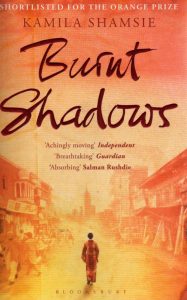
Burnt Shadows is a novel deeply invested in the politics of postcolonial identity and nationhood
Reviewed by Shoukat Lohar
Introduction

Kamila Shamsie is a contemporary British-Pakistani novelist who has gained critical acclaim for her insightful explorations of themes of identity, nationality, history, and power. Born in Karachi, Sindh, Shamsie has lived in both Pakistan and the United Kingdom, and her work reflects her nuanced understanding of the complex cultural and political dynamics of both societies.
In this essay, we will explore one of Shamsie’s most celebrated novels, Burnt Shadows, and analyze its postcolonial themes, characters, and narrative structure.
Postcolonial Themes in Burnt Shadows
Burnt Shadows is a novel deeply invested in the politics of postcolonial identity and nationhood. Set in three distinct historical periods – pre-World War II Japan, post-Partition India, and post-9/11 Karachi and Afghanistan – the novel explores the legacy of colonialism and the ongoing struggles of nations and individuals to define themselves in the aftermath of imperialism.
One of the key themes of the novel is the idea of belonging and identity. Shamsie presents her characters as complex, multidimensional individuals whose identities are shaped by a multitude of factors, including race, nationality, religion, and family history.
The novel’s protagonist, a Japanese woman named Hiroko Tanaka, is a particularly poignant embodiment of this theme.
As a survivor of the atomic bombing of Nagasaki, Hiroko’s physical and emotional scars are emblematic of the trauma inflicted upon individuals and nations by colonialism and war.
Another important theme in Burnt Shadows is the power of language and storytelling.
Shamsie weaves together multiple narrative threads and perspectives to create a tapestry of interconnected stories that span continents and centuries. In doing so, she suggests that the stories we tell ourselves about our past, our present, and our future have a profound impact on our sense of self and our place in the world.
Characters in Burnt Shadows
The characters in Burnt Shadows are richly drawn and complex, reflecting the diversity of the societies and historical periods in which the novel is set. In addition to Hiroko, the novel’s cast of characters includes Sajjad Ashraf, a Pakistani man who becomes Hiroko’s lover in Karachi; Konrad Weiss, a German who befriends Hiroko in pre-WWII Japan; and Elizabeth Burton, an Englishwoman who marries Sajjad after Hiroko’s departure.
One of the most interesting aspects of Shamsie’s characterization is her refusal to reduce her characters to simplistic stereotypes or archetypes. Instead, she allows each character to develop organically, revealing their strengths, weaknesses, and contradictions over time.
Narrative Structure
The narrative structure of Burnt Shadows is complex and multilayered, with multiple plotlines and perspectives interwoven to create a dense and intricate tapestry.
In Karachi, it was easy to believe that there was no such thing as history. The city was a jumble of cultures and epochs, a chaotic mix of old and new, traditional and modern
The novel’s structure is reflective of its postcolonial themes, suggesting that the legacy of colonialism is not a linear or straightforward process, but rather a web of interconnected relationships and historical forces.
One of the most interesting features of the novel’s structure is its use of language and symbolism to connect seemingly disparate events and characters. For example, the image of burnt shadows – a reference to the lingering radiation burns on Hiroko’s skin – serves as a metaphor for the enduring legacy of imperialism and war, connecting the novel’s various historical periods and characters.
Critical point of view and Analysis
Burnt Shadows has been widely praised for its nuanced exploration of postcolonial themes and its deft characterization and narrative structure. Critics have noted the novel’s ability to weave together multiple historical periods and perspectives into a cohesive whole, creating a rich and complex portrait of the legacy of colonialism.
However, some critics have also noted the novel’s occasionally heavy-handed approach to its themes has decreased its power of catharsis. Over all its masterpiece because of its content and recreation.
Backdrop of the novel
 Postcolonial Literature: Postcolonial literature is a genre of literature that emerged in the aftermath of colonialism. It is characterized by its exploration of themes of identity, nationalism, and the legacy of colonialism on formerly colonized societies. Postcolonial literature often challenges the dominant narratives and power structures of colonialism, and seeks to give voice to the marginalized and oppressed.
Postcolonial Literature: Postcolonial literature is a genre of literature that emerged in the aftermath of colonialism. It is characterized by its exploration of themes of identity, nationalism, and the legacy of colonialism on formerly colonized societies. Postcolonial literature often challenges the dominant narratives and power structures of colonialism, and seeks to give voice to the marginalized and oppressed.
Hybridity and Cosmopolitanism in Burnt Shadows: Hybridity and cosmopolitanism are two key themes that run throughout Burnt Shadows. The novel’s characters are all products of the complex cultural and historical intersections that occur in the wake of colonialism. As a result, they embody a hybridity of identity that reflects the diversity and complexity of postcolonial societies.
Karachi, where much of the novel is set, is a particularly interesting embodiment of this hybridity and cosmopolitanism.
As a port city and a center of trade and commerce, Karachi has long been a melting pot of different cultures and identities. In Burnt Shadows, Shamsie explores the various ways in which the city’s history and geography have shaped the identities of its inhabitants.
Some striking excerpts from the novel
“Hiroko had never before realized how much she was a product of her own country. She had her language, her history, her food, her art. All of it was uniquely Japanese, and all of it was now lost to her.” (Chapter 1)
This excerpt highlights the theme of identity and belonging that runs throughout the novel. Hiroko’s sense of self is intimately tied to her Japanese identity, and the loss of that identity after the bombing of Nagasaki leaves her adrift and disconnected.
“In Karachi, it was easy to believe that there was no such thing as history. The city was a jumble of cultures and epochs, a chaotic mix of old and new, traditional and modern.” (Chapter 5)
This excerpt highlights the cosmopolitanism and hybridity of Karachi, and suggests that the city’s complex history and geography have made it a place where traditional notions of history and identity are constantly being challenged and redefined.
“The war was over, but the peace was no less violent. In India and Pakistan, the Partition had unleashed a wave of communal violence that left millions dead or displaced.” (Chapter 6)
This excerpt highlights the violence and trauma that often accompany the process of decolonization. The Partition of India and Pakistan was a particularly brutal and traumatic moment in postcolonial history, and the novel does not shy away from exploring its impact on the lives of ordinary people.
“It was a new kind of war, one in which the enemy was not a nation or an ideology, but a shadowy network of individuals with no fixed address and no identifiable uniform.” (Chapter 13)
Conclusions
This excerpt highlights the ways in which the events of 9/11 and the subsequent War on Terror have transformed the nature of conflict in the postcolonial world. The novel suggests that the legacy of colonialism and imperialism has created a world in which traditional notions of war and peace no longer apply.
______________
 Shoukat Lohar is Assistant professor in English at Mehran University of Engineering and Technology Jamshoro. He can be reached at Shoukat.ali@faculty.muet.edu.pk
Shoukat Lohar is Assistant professor in English at Mehran University of Engineering and Technology Jamshoro. He can be reached at Shoukat.ali@faculty.muet.edu.pk